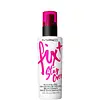What's inside
What's inside
 Key Ingredients
Key Ingredients

 Benefits
Benefits

 Concerns
Concerns

 Ingredients Side-by-side
Ingredients Side-by-side

Water
Skin ConditioningC9-12 Alkane
SolventGlycerin
HumectantButylene Glycol
HumectantPvp
Emulsion StabilisingCucumis Sativus Fruit Extract
EmollientCamellia Sinensis Leaf Extract
AntimicrobialChamomilla Recutita Extract
Skin ConditioningTocopheryl Acetate
AntioxidantCaffeine
Skin ConditioningIsononyl Isononanoate
EmollientPPG-26-Buteth-26
Skin ConditioningPanthenol
Skin ConditioningArginine
MaskingTrimethylsiloxysilicate
EmollientPEG-40 Hydrogenated Castor Oil
EmulsifyingPolydextrose
HumectantHydrogenated Lecithin
EmulsifyingCitric Acid
BufferingParfum
MaskingBHT
AntioxidantDisodium EDTA
Chlorphenesin
AntimicrobialPhenoxyethanol
PreservativeWater, C9-12 Alkane, Glycerin, Butylene Glycol, Pvp, Cucumis Sativus Fruit Extract, Camellia Sinensis Leaf Extract, Chamomilla Recutita Extract, Tocopheryl Acetate, Caffeine, Isononyl Isononanoate, PPG-26-Buteth-26, Panthenol, Arginine, Trimethylsiloxysilicate, PEG-40 Hydrogenated Castor Oil, Polydextrose, Hydrogenated Lecithin, Citric Acid, Parfum, BHT, Disodium EDTA, Chlorphenesin, Phenoxyethanol
Water
Skin ConditioningAlcohol Denat.
AntimicrobialPvp
Emulsion StabilisingDimethicone PEG-7 Phosphate
CleansingPPG-3 Benzyl Ether Myristate
EmollientPolyhydroxystearic Acid
EmulsifyingDipropylene Glycol
HumectantIsononyl Isononanoate
EmollientEthylhexyl Isononanoate
EmollientCaprylyl Glycol
EmollientSodium Cocamidopropyl Pg-Dimonium Chloride Phosphate
CleansingMethyl Methacrylate Crosspolymer
Glycereth-5 Lactate
EmollientPhenylpropanol
MaskingPropanediol
SolventMethyl Diisopropyl Propionamide
MaskingSodium Hydroxide
BufferingParfum
MaskingAloe Barbadensis Leaf Juice
Skin ConditioningMaltodextrin
AbsorbentPoloxamer 407
EmulsifyingPentaerythrityl Tetra-Di-T-Butyl Hydroxyhydrocinnamate
AntioxidantTocopherol
AntioxidantPotassium Sorbate
PreservativeSodium Benzoate
MaskingWater, Alcohol Denat., Pvp, Dimethicone PEG-7 Phosphate, PPG-3 Benzyl Ether Myristate, Polyhydroxystearic Acid, Dipropylene Glycol, Isononyl Isononanoate, Ethylhexyl Isononanoate, Caprylyl Glycol, Sodium Cocamidopropyl Pg-Dimonium Chloride Phosphate, Methyl Methacrylate Crosspolymer, Glycereth-5 Lactate, Phenylpropanol, Propanediol, Methyl Diisopropyl Propionamide, Sodium Hydroxide, Parfum, Aloe Barbadensis Leaf Juice, Maltodextrin, Poloxamer 407, Pentaerythrityl Tetra-Di-T-Butyl Hydroxyhydrocinnamate, Tocopherol, Potassium Sorbate, Sodium Benzoate
 Reviews
Reviews

Ingredients Explained
These ingredients are found in both products.
Ingredients higher up in an ingredient list are typically present in a larger amount.
Isononyl Isononanoate is a synthetic skin-conditioner and texture enhancer. It is created from nonanoic acid, a fatty acid found in cocoa and lavender oil.
As an emollient, Isononyl Isononanoate helps keep your skin soft and smooth. This is because emollients create a barrier on the skin to trap moisture in.
Isononyl Isononanoate helps give products a velvet feel and improves spreadability.
Learn more about Isononyl IsononanoateParfum is a catch-all term for an ingredient or more that is used to give a scent to products.
Also called "fragrance", this ingredient can be a blend of hundreds of chemicals or plant oils. This means every product with "fragrance" or "parfum" in the ingredients list is a different mixture.
For instance, Habanolide is a proprietary trade name for a specific aroma chemical. When used as a fragrance ingredient in cosmetics, most aroma chemicals fall under the broad labeling category of “FRAGRANCE” or “PARFUM” according to EU and US regulations.
The term 'parfum' or 'fragrance' is not regulated in many countries. In many cases, it is up to the brand to define this term.
For instance, many brands choose to label themselves as "fragrance-free" because they are not using synthetic fragrances. However, their products may still contain ingredients such as essential oils that are considered a fragrance by INCI standards.
One example is Calendula flower extract. Calendula is an essential oil that still imparts a scent or 'fragrance'.
Depending on the blend, the ingredients in the mixture can cause allergies and sensitivities on the skin. Some ingredients that are known EU allergens include linalool and citronellol.
Parfum can also be used to mask or cover an unpleasant scent.
The bottom line is: not all fragrances/parfum/ingredients are created equally. If you are worried about fragrances, we recommend taking a closer look at an ingredient. And of course, we always recommend speaking with a professional.
Learn more about ParfumPvp is a water-soluble synthetic polymer and common hairstyling ingredient. It is a film-forming ingredient and used to "hold" specific shapes of hair.
Pvp is less effective in high-humidity. It tends to draw moisture, but this moisture dismantles the structure and "hold".
Water. It's the most common cosmetic ingredient of all. You'll usually see it at the top of ingredient lists, meaning that it makes up the largest part of the product.
So why is it so popular? Water most often acts as a solvent - this means that it helps dissolve other ingredients into the formulation.
You'll also recognize water as that liquid we all need to stay alive. If you see this, drink a glass of water. Stay hydrated!
Learn more about Water